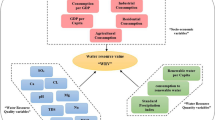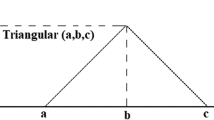Abstract
Society benefits from rivers in many aspects. To the extent of water resources management, one of the salient issues is that the social benefit of in-stream water quality improvements is often difficult to be quantified for possible cost justification in many water pollution control programs. The difficulties arise from that many service flows of water quality are not channelled through the market system to consumers and producers. With different socio-economic structures, such valuation could be even more challenging when taking river basins with low-income level into account. Recent advances in fuzzy set theory provide a germain insight to viewing the in-stream water quality as a kind of fuzzy resource due to varying awareness of the quality of life. This paper provides a technical analysis using the fuzzy contingent valuation mothod (FCVM) to value in-stream water quality improvements in terms of three fuzzy resources from aesthetic to recreational, and to ecological aspects. Traditional CVM may allow interest groups or affected parties to join and present a more flexible asset assessment with respect to the prescribed environmental features in the river corridor. Yet the FCVM provides a mechanism that lies in providing a mapping (via fuzzy set theory) from a survey of respondents’ valuation of subjective assessments of water quality into objective economic measures in terms of water quality parameters that management can more directly manipulate. With this new tool, the traditional CVM assessment outputs in a well-developed river basin may even lead to derive a simular valuaton function in a form of a regression equation in a developing river basin where the incme level is relatively low. As part of the sustainablity analysis basin wide, a case study in Taiwan showed that such effort may provide supportive information for cost benefit analysis in many water pollution control programs corresponding to different temporal and spatial scales.








Similar content being viewed by others
References
Barton DN (2002) The transferability of benefit transfer: contingent valuation of water quality improvements in Costa Rica. Ecol Eco 42(1–2):147–164
Bergstrom JC, Kevin JB, Poe GL (eds) (2001) The economic value of water quality. In: New horizons in environmental economics, Elgar, Northampton Mass
Boyle KJ, Bergstrom JC (1992) “Benefit transfer studies: myths, pragmatism, and idealism. In: Water resources research, vol. 28, No. 3, pp 657–663
Burrows AM, House MA (1989) Public’s perception of water quality and the use of water for recreation. In: Laikari H (ed) River basin management-V. Pergamon Press, London, pp 371–379
Cameron TA, Huppert DD (1989) OLS versus ML estimation of non-market resource values with payment card interval data. J Environ Eco Manag 17:230–246
Cameron TA, Poe GL, Ethier RG, Schulze WD (2002) Alternative non-market value-elicitation methods: are the underlying preferences the same? J Environ Eco Manag 44(3):391–425
Chang NB, Chen HW (2001) Identification of river water quality by fuzzy synthetic evaluation approach. J Environ Manag 64:1–13
Chang NB, Lu HY (1997) A new approach for long term planning of solid waste management systems using fuzzy global criterion. J Environ Sci Health A32(4):1025–1047
Chang NB, Wang SF (1996) Managerial fuzzy optimal planning for solid waste management systems. J Environ Eng ASCE 122(7):649–658
Chang NB, Chen YL, Wang SF (1997) A fuzzy interval multi-objective mixed integer programming approach for the optimal planning of metropolitan solid waste management system. Fuzzy Sets Syst 89(1):35–60
Deshpande AW, Raje DV, Khanna P (1996) Fuzzy description of river water quality. In: Proceedings of EUFIT’96, ELITE Foundation, Promenade 9, 52076, Aachen, Germany, pp 1795–1801
Downing M, Ozuna T Jr (1996) Testing the reliability of the benefit function transfer approach. J Environ Eco Manag 30:316–322
Eom KB (1999) Fuzzy clustering approach in unsupervised sea-ice classification. Neurocomputing 25:149–166
Farber S (1988) The value of coastal wetlands for recreation: an application of travel cost and contingent valuation methodologies. J Environ Manag 26:299–312
Freeman AM (1993) The measurement of environmental and resource values. Resources for the Future, Washington DC
Goffe PL (1995) The benefits of improvements in coastal water quality: a contingent approach. J Environ Manag 45:305–317. DOI: 10.1006/jema.1995.0078
Granath G (1984) Application of fuzzy clustering and fuzzy classification to evaluate the provenance of glacial till. Math Geol 16(3):283–301
Gregory KJ, Davis RJ (1993) The perception of riverscape aesthetics: an example from two hampshire rivers. J Environ Manag 39:171–185. DOI: 10.1006/jema.1993.1062
Heinonen P, Herve S (1994) The development of a new water quality classification system for Finland. Water Sci Tech 30(10):21–24
Kamel MS, Selim SZ (1994) New algorithms for solving the fuzzy clustering problem. Pattern Recog 27(3):421–428
Kirchhoff S, Colby BG, LaFrance JT (1997) Evaluation the performance of benefit transfer: an empirical inquiry. J Environ Eco Manag 33(1):75–93
Kreinovich V, Nguyen HT, Starks SA, Yam Y (1998) Decision making based on satellite images: optimal fuzzy clustering approach. Proc IEEE Conf Decision Contr 4:4246–4251
Kwak SJ, Russell CS (1994) Contingent valuation in Korean environmental planning: a pilot application to the protection of drinking water quality in Seoul. J Environ Eco Manag 4:511–526
Lipton DW, Wellman KF, Sheifer IC, Weiher RF (1995) Economic valuation of natural resources—a handbook for coastal resources policymakers. In: NOAA Coastal Ocean Prpgram Decision Analysis Series No. 5, NOAA Coastal Ocean Office, Silver Spring, p 131
Loomis JB (1992) The evolution of a more rigorous approach to benefit transfer. Water Res Res 28(3):701–705
Luken RA, Reed Johnson F, Kibler V (1992) Benefits and costs of pulp and paper effluent controls under the clean water act. Water Res Res 28(3):665–674
McBratney AB, Moore AW (1985) Application of fuzzy sets to climatic classification. Agric Forest Meteorol 35:165–185
McConnell KE (1992) Model building and judgment: implication for benefit transfers with travel cost models. Water Res Res 28(3):695–700
Michell RC, Carson R (1989) Using surveys to value public goods: the contingent valuation method. Resources for the Future, Washington DC
Morrison M (2002) Choice modeling and tests of benefit transfer. Am J Agric Eco 84(1):161–170
National Science Foundation (2003) Complex environmnetal systems: sciences for earth, life, and society in the 21th Century. NSF advisory Committee for Environmental Research and Education, USA
Press J, Soderqvist T (1998) On estimating the benefits of groundwater protection: a contingent valuation study in Milan.In: Swanson T, Vighi M (eds) Regulating Chemical Accumulation in the Environment, Chap 6 Cambridge University Press, Cambridge
Shaw D, Chen YL, Tsai LH (1998) Valuing the improvements in the water quality of and the scenery surrounging the Tamshui River system in Taiwan. Taipei Economic Inquiry 35(1):29–60
Shaw D, Chen YL, Lin YM (1999) An alternative approach to combining revealed and stated preference data: valuing water quality of the river system in Taipei. Environ Eco Policy Studies 2(2):97–112
Shih FY, Chen GP (1994) Classification of landsat remote sensing images by a fuzzy unsupervised clustering algorithm. Inf Sci Appl 1:97–116
Sii HI, Sherrard JH, Wilson TE (1993) A water quality index based on fuzzy sets theory. In: Proceedings of 1993 Joint CSCE-ASCE National Conference on Environmental Engineering, Montreal, pp 1727–1734
Smith PN (1994) Applications of fuzzy sets in the environmental evaluation of projects. J Environ Manag 42:365–388. DOI: 10.1006/jema.1994.1078
Smith DG, Davies-Colley RJ (1992) Perception of water clarity and color in terms of suitability for recreational use. J Environ Manag 36:225–235
Tao Y, Xinmiao Y (1998) Fuzzy comprehensive assessment, fuzzy clustering analysis and its application for urban traffic environment quality evaluation. In: Transportaion Research, Part D: Transport and Environment, vol 3, pp 51–57
Trauwaert E, Kaufman L, Rousseeuw P (1991) Fuzzy clustering algorithms based on the maximum likelihood principle. Fuzzy Sets Syst 42:213–227
United States Environmental Protection Agency (USEPA) (2002) http://www.epa.gov/swerosps/ej/
Vossler CA, Kerkvliet J (2003) A criterion validity test of the contingent valuation method: comparing hypothetical and actual voting behavior for a public referendum, J Environ Eco Manag 45(3):631–649. DOI: 10.1016/S0095
Willis KG, Garrod GD (1993) Valuing landscape: a contingent valuation approach. J Environ Manag 37:1–22. DOI: 10.1006/jema.1993.1001
Xu H, Liu D, Wu H (2001) Environmental regionalization for the management of township and village enterprises in China. J Environ Manag 63:203–210. DOI: 10.1006/jema.2001.0449
Zadeh LI (1965) Fuzzy Sets. Inf Contr 8:338–353
Author information
Authors and Affiliations
Corresponding author
Rights and permissions
About this article
Cite this article
Chen, HW., Chang, NB. & Shaw, D. Valuation of in-stream water quality improvement via fuzzy contingent valuation method. Stoch Environ Res Ris Assess 19, 158–171 (2005). https://doi.org/10.1007/s00477-004-0223-3
Published:
Issue Date:
DOI: https://doi.org/10.1007/s00477-004-0223-3




